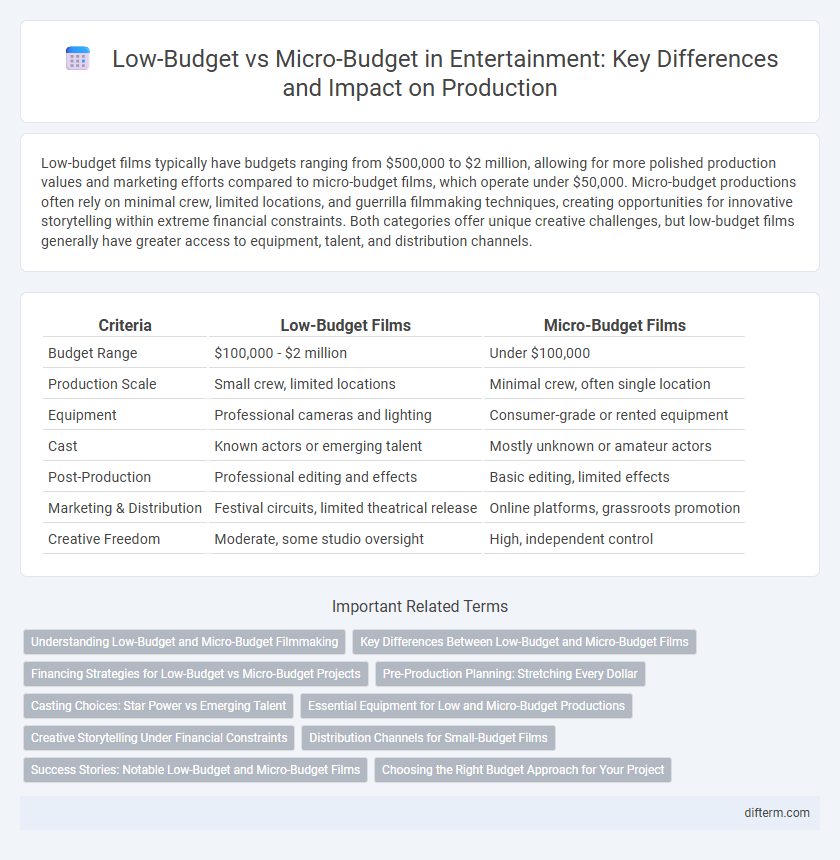Low-budget films typically have budgets ranging from $500,000 to $2 million, allowing for more polished production values and marketing efforts compared to micro-budget films, which operate under $50,000. Micro-budget productions often rely on minimal crew, limited locations, and guerrilla filmmaking techniques, creating opportunities for innovative storytelling within extreme financial constraints. Both categories offer unique creative challenges, but low-budget films generally have greater access to equipment, talent, and distribution channels.
Table of Comparison
| Criteria | Low-Budget Films | Micro-Budget Films |
|---|---|---|
| Budget Range | $100,000 - $2 million | Under $100,000 |
| Production Scale | Small crew, limited locations | Minimal crew, often single location |
| Equipment | Professional cameras and lighting | Consumer-grade or rented equipment |
| Cast | Known actors or emerging talent | Mostly unknown or amateur actors |
| Post-Production | Professional editing and effects | Basic editing, limited effects |
| Marketing & Distribution | Festival circuits, limited theatrical release | Online platforms, grassroots promotion |
| Creative Freedom | Moderate, some studio oversight | High, independent control |
Understanding Low-Budget and Micro-Budget Filmmaking
Low-budget filmmaking typically involves budgets ranging from $1 million to $5 million, allowing for modest production values, professional cast, and limited locations. Micro-budget films, often under $50,000, demand creative resourcefulness, minimal crew, and reliance on digital technology to maximize production quality. Understanding the distinctions informs strategic decisions about financing, distribution, and marketing approaches within the independent film industry.
Key Differences Between Low-Budget and Micro-Budget Films
Low-budget films typically have production costs ranging from $500,000 to $2 million, allowing for professional cast, crew, and moderate special effects, while micro-budget films generally operate under $100,000, relying heavily on minimal resources and improvisation. Low-budget productions often secure limited theatrical releases and festival circuits, whereas micro-budget films primarily target digital platforms and local screenings. Differences in financing, scale of production, and marketing strategies distinctly shape the creative freedom and distribution potential between these two categories.
Financing Strategies for Low-Budget vs Micro-Budget Projects
Low-budget projects typically secure financing through a mix of private investors, grants, and pre-sales, balancing risk with moderate production values. Micro-budget films rely heavily on crowdfunding platforms, personal savings, and in-kind contributions, emphasizing creative resourcefulness over financial scale. Effective financing strategies prioritize building strong relationships with niche audiences and leveraging digital distribution channels to maximize return on minimal investments.
Pre-Production Planning: Stretching Every Dollar
Pre-production planning in low-budget and micro-budget films emphasizes meticulous scheduling, resource allocation, and creative problem-solving to maximize limited funds. Every dollar is strategically spent on essential elements such as location scouting, script refinement, and securing affordable talent, ensuring efficient workflow during filming. This careful planning ultimately reduces costly reshoots and delays, enabling successful project completion within financial constraints.
Casting Choices: Star Power vs Emerging Talent
Low-budget films often rely on the casting of recognizable star power to attract audiences and secure distribution, leveraging established names to boost marketability and credibility. In contrast, micro-budget productions prioritize emerging talent, providing opportunities to fresh actors and allowing for creative risks without the financial burden of high-profile salaries. The choice between star-powered casts and new faces significantly impacts a film's promotional strategy, audience reach, and overall production dynamics.
Essential Equipment for Low and Micro-Budget Productions
Essential equipment for low-budget productions typically includes affordable digital cameras, basic lighting kits, and portable audio recorders, which balance quality and cost efficiency. Micro-budget productions often rely on compact, multi-functional gear like smartphone cameras with external microphones and DIY lighting solutions to maximize limited resources. Prioritizing versatile equipment that supports clear visuals and sound ensures production value remains high despite financial constraints.
Creative Storytelling Under Financial Constraints
Low-budget films, typically ranging from $100,000 to $2 million, allow directors to craft compelling narratives with limited resources, balancing production quality and storytelling innovation. Micro-budget films, often under $100,000, require even greater ingenuity, pushing filmmakers to emphasize strong character development and inventive plot structures to engage audiences. Both budget categories challenge creators to maximize emotional impact and originality despite stringent financial constraints.
Distribution Channels for Small-Budget Films
Small-budget films often leverage traditional distribution channels such as film festivals, digital platforms like Amazon Prime and iTunes, and limited theatrical releases to reach targeted audiences effectively. Micro-budget films primarily rely on online streaming services, social media marketing, and niche platforms like Vimeo On Demand to maximize visibility without extensive promotional costs. Both budgets face challenges but benefit from evolving digital distribution technologies that democratize access to viewers worldwide.
Success Stories: Notable Low-Budget and Micro-Budget Films
Notable low-budget films like "Paranormal Activity" (budget $15,000) and micro-budget gems such as "The Blair Witch Project" (budget $60,000) exemplify remarkable success in the entertainment industry, grossing hundreds of millions worldwide. These films utilized innovative storytelling and grassroots marketing strategies to connect with audiences despite minimal funding. Their commercial success and critical acclaim underscore the potential of low-budget and micro-budget productions to disrupt traditional filmmaking models and inspire independent creators.
Choosing the Right Budget Approach for Your Project
Choosing the right budget approach for your entertainment project depends on the scope and resources available, with micro-budget films typically under $100,000 and low-budget projects ranging up to several million dollars. Micro-budget productions demand creative resourcefulness and often rely on minimal crew and locations, while low-budget films allow for higher production values and broader distribution opportunities. Understanding your project's goals and audience expectations is essential for selecting a budget strategy that maximizes quality and impact within financial constraints.
low-budget vs micro-budget Infographic

 difterm.com
difterm.com